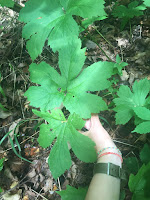 |
| Black Cohosh |
 |
| Black Cohosh |
I had the opportunity to go in the field with Ranger Pat Jackson, who gave me a crash course in much more than just those plants most often poached-- but also wildflowers, trees, and other Missouri native species as well as their specific ecological roles. I look up to his knowledge about the park's natural resources, and hope to hone my role as a naturalist as he has.
Some of the plants that we were able to identify on our patrol were black cohosh, goldenseal, as well as a list of native trees and wildflowers too long to list here.
Black cohosh can be identified by its tall flowering stalk with very specific white bulbed flowers, with compound leaves with three, jagged-edged leaflets. Black cohosh root was originally used in Native American medicine to treat many different symptoms, including those associated with menopause and menstrual cramps.
 |
| Goldenseal |
Goldenseal can be identified as a short plant with one stem that often (but not always, sometimes its just a single leaf) breaks off into two leaves-- one larger and one smaller, which grow in patches. Also, these can be identified by a small berry that is similar to a raspberry which forms in early June. Goldenseal root has many respiratory and digestive uses-- including to treat the common cold, hay fever, and general stomach upset.
My last goal before I leave the Ozarks are to identify ginseng, and although it is more work to find (its habitat is thick, wet slopes), it also is highly sought after by poachers, due to the fact that its sale value is very high.

No comments:
Post a Comment